Term 1 Chapter 4 | 5th Science - Science in Everyday Life | 5th Science : Term 1 Unit 4 : Science in Everyday Life
Chapter: 5th Science : Term 1 Unit 4 : Science in Everyday Life
Science in Everyday Life
UNIT 4
Science in Everyday Life

Learning Objectives
After completing this
lesson, students will be able to
• know about Scientists
from Tamil Nadu.
• understand the reason
for the blue appearance of the sky.
• differentiate reversible
and irreversible processes in daily life.
• get awareness about
waste materials generated in home and school environment.
Introduction
Science has helped us to find solution
to many of our problems. It has shaped our daily life also. The world we are
living in is not the same as before. It is changing everyday, infact every
hour. We see lot of changes around us. Some of them are reversible and some of
them are irreversible. Irreversible changes like burning of wastes pollute our
home and school environment. We need to know about waste management and proper
disposable of wastes. Let us study about them in this lesson.
I. Scientists from Tamil Nadu
Tamil Nadu has a long history of science
since ancient times. Scientific concepts can be seen in ancient Tamil
literatures. Tamil Nadu has produced many scientists who have contributed to
the world of science. The following table gives the names of some of the
scientsts from Tamil Nadu and their contributions.
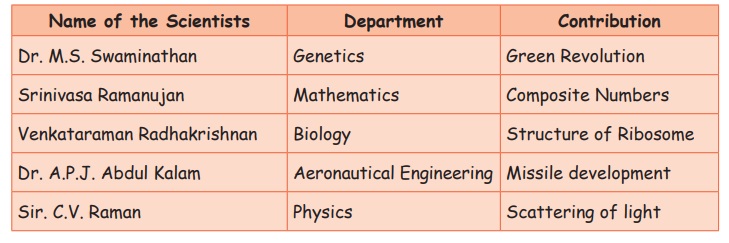
1. Sir. C.V. Raman (1888-1970)
Chandrasekhara
Venkata Raman was born at Trichirapalli, Tamil Nadu on 7th November, 1888. In
1904, he completed his Bachelor of Arts (B.A) degree at Presidency College,
Chennai. He stood first and won gold medal in Physics. In 1907, he got his
Master of Science (M.Sc) degree from University of Madras.

Sir.C.V. Raman won the Nobel Prize in Physics in the year 1930 for his work in scattering of light. In 1954, he was awarded the Bharat Ratna.
Blue appearance of Sky
One
day in the summer of 1921, Sir.C.V. Raman was on the deck of a ship sailing in
the mediterranean sea. He was observing the blue colour of the sky and started
reasoning it. He concluded that sunlight is scattered by the gases and
particles present in the air. The white light we see is composed of different
colours such as violet, indigo, blue, green, yellow, orange and red (VIBGYOR).
Among these colours, blue is scattered more. Because of this reason, sky appears
blue most of the time. During sunrise and sunset, rays have to travel long
distance. As they travel, all other colours except red are scattered. So, sky
appears red at sunrise and sunset.
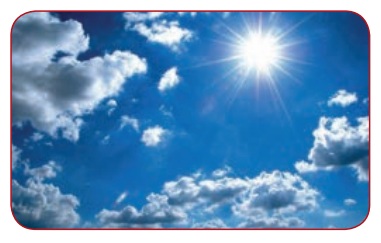
Do you know?
National Science Day is celebrated
on 28th of February in order to commemorate the invention of the Raman Effect
by Sir. Chandrasekhara Venkata Raman on the same day in the year 1928
2. Dr. A.P.J. Abdul Kalam (1931-2015)
Avul
Pakir Jainulabdeen Abdul Kalam was an Aeronautical Scientist. He was born on
15th October 1931 in Rameshwaram, Tamil Nadu. He got his Bachelor of Science
(B.Sc) degree from St.Joseph‛s College, Trichirappalli in 1954. In 1960, he got
his degree in Aeronautical Engineering from Madras Institute of Technology.

He was involved in India‛s missile development programme and thus came to be known as Missile Man of India. He also served as the President of India (2002-2007) and widely referred to as the People‛s President. He was awarded Padma Bhusan in 1981, Padma Vibhusan in 1990 and Bharat Ratna in 1997. He has written many books like Wings of Fire, India 2020 and Ignited minds.
II. Changes Around Us
Change is the transition of a substance
from one form to another. We see many changes around us. We see changes like
day and night, summer and winter and so on. We also see changes in objects.
Growth of a tree, ripening of fruits, falling of leaves are some of the changes
taking place around us. You can observe changes in you also. Your height and
weight increase, hair and nail grow and you have grown up as a whole compared to
last year. These can be classified as reversible and irreversible changes.
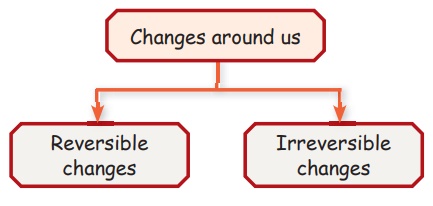
1. Reversible Changes
Changes which can be reversed are called
reversible changes. If you keep water in the freezer for some time, it is
tranformed into ice. If it is taken out, it becomes water again. This is a
reversible change.
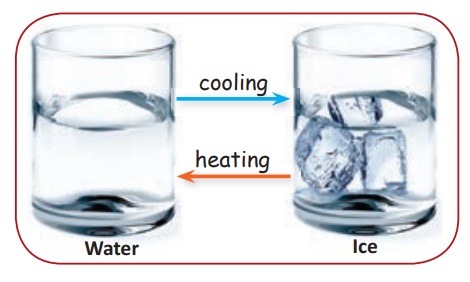
2. Irreversible Changes
Changes
which cannot be reversed are called irreversible changes. If you burn a piece
of paper it burns and turns into ash. It cannot become paper again. This is an
irreversible change.

Do you know?
Irreversible changes are also known as permanent changes. Processes like heating, burning, mixing and powdering cause permanent changes
Activity 1
Take an elastic band and
stretch it to the maximum. Now release it. What do you observe?
Cut it now into pieces.
Can you get the band back again?

Answer: NO
Activity 2
Take a balloon and blow
air into it. You can see that the shape and size of the balloon is changed. Now
let the air escape from the balloon. What do you observe now?
Now blow it to its full size and prick it with the tip of a pin. It is burst. Can you get the balloon back?
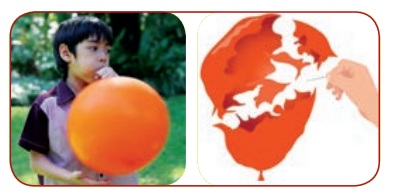
Answer: NO
From
these activities we can observe some differences between reversible and
irreversible changes. Differences between reversible and irreversible changes
are listed below.
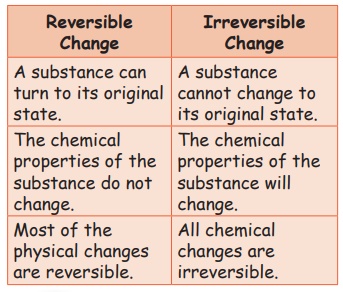
Activity 3
Which of these common
changes, you think, can be reversed?
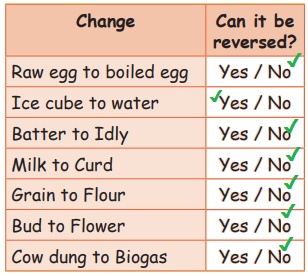
III. Wastes Generated in our
Environment
Waste is any substance which is discarded
after primary use. It is worthless, defective and of no use. They are unwanted
and undesirable materials.

1. Household
Wastes
Wastes
from home is known as household waste. Solid wastes disposed from home and
apartments comprise of garbage and rubbish (bottles, cans, clothings, composts,
disposable items, food packings, news papers, magazines and trimmings). We can
classify the household wastes as below.
Organic wastes: Kitchen wastes, Vegetables, Flowers,
Leaves, Fruits.
Toxic
wastes: Old
medicines, Paints, Chemicals, Bulbs, Spray cans, Fertilizers, Pesticide
containers, Batteries, Shoe polish.
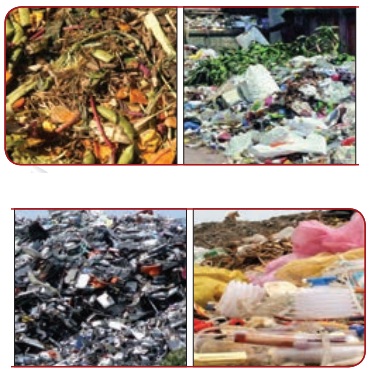
Recyclable
wastes: Paper,
Glass, Metals, Plastics.
Solid
wastes: Cloths
soiled with blood and other body fluids.
e- wastes: Computer parts. Electronic materials. Cell phone parts. CFL bulbs.
Do you know?
• 40 million tans of electronic waste is generated every year
worldwide.
• e-waste comprises 70% of our overall toxic waste.
• e-waste contains hundreds of substances.of which many are
toxic.
Activity 4
Collect the wastes from your house before it is thrown into
dustbin. Separate them into two groups.
Group 1: Garbage from the kitchen like fruit and vegetable peel, egg
shells, waste food, tea leaves, news papers, dry leaves and paper bags.
Group 2: Pieces of cloth, polythene bags, brocken glass, aluminum
wrappers, nails, old shoes and broken toys.
Find out how you can dispose them properly.
2. Wastes
from School
You
leave many waste materials inside your class rooms and throw away many things
in the school campus. If they are not collected and disposed properly, your
environment will be polluted. Papers, pen and its parts, blades, chocolate covers
and plastic items are found in the school environment. The single most common
materilal generated in schools is food waste. Food is not only wasted but it is
also thrown away everywhere, making your surrounding unclean.
In
a survey conducted, it is found that food waste accounts for 23.9% of the total
wastes generated in the school and recyclable paper like card board, white
paper and mixed papers accounted for 23.5% of the total waste. To keep our
surrounding clean, we need to have a proper waste disposal system.

Do you know?
Each one in our state capital (Chennai) contributes 700 gram of
waste everyday. It is the highest in our country.
3. Need
for Proper Disposal of Waste
With
so much of wastes lying everywhere, what do you think that we should do? We
urgently need a proper waste management system. Waste management is needed for
the following reasons.
To control pollution
•
Various pollutions like water pollution, air pollution and soil pollution can
be avoided.
To conserve natural
resources
•
Waste disposal is important for the conservation of our environmental resources
like forest, minerals and water.
To control spread of
diseases
•
Spread of infectious diseases can be controlled.
Recycle for further
use
•
Wastes can be recycled to get products for further use.
4. Ways
to Reduce Waste
The
best place to start changes is our home. We need to learn how to reduce, reuse
and recycle wastes. The following practices will be helpful to reduce wastes in
our home and school environment.
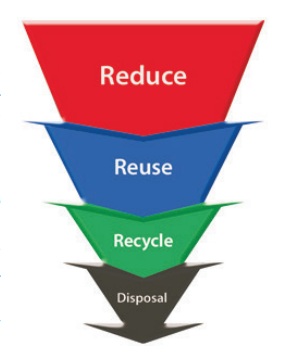
•
Use reusable and recyclable bags and containers.
•
Avoid one time use items and use items which can be used permanently.
•
Segregate wastes into bio-degradable and non-biodegradable items and hand over
them to the municipal and corporation people who collect them.
•
Do not throw away your wastes every where. Put them in dustbins and dispose
them properly.
•
Don‛t waste food. Waste food in schools can be collected and used to feed
cattles.
•
Organic wastes can be converted into manures.
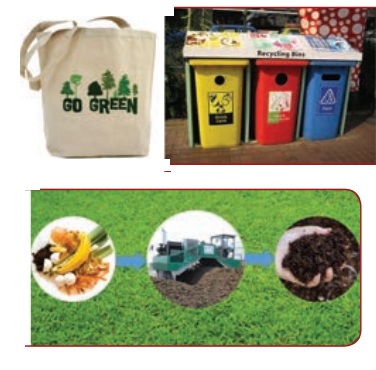
Related Topics